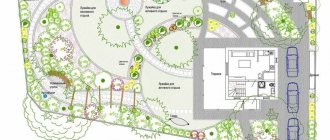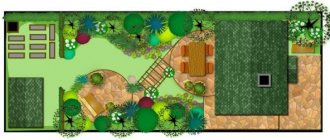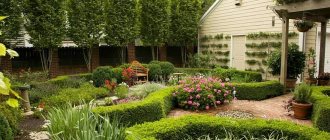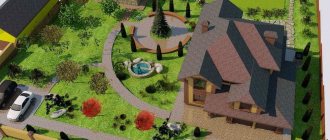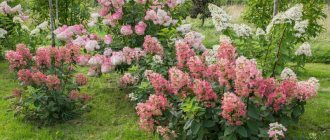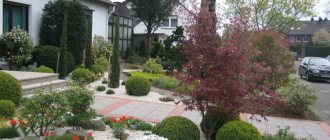The issue of landscape design worries many. In addition to growing useful vegetation such as potato plantations and beds of scapula, onions, and radishes, the vast majority of summer residents strive to decorate their plots of land, even if “one hundred square meters” are scarce. Not to mention the owners of country houses, many of whom do not grow potatoes, but are not indifferent to the beauty and improvement of their properties. Everyone improves their land to the best of their ability and understanding of what is beautiful. Someone chooses a design carefully verified by specialists, where the garden area is laid out with a clear pattern of paths and bosquets, and each plant is symmetrical, regular in shape, in its place, in its own “graph”. Another plants every free piece of land with a colorful flower bed, and places what does not fit in the flower beds in numerous hanging flowerpots or boxes. The third suits the correct lawn, an ideal, emerald green color. There is also fashion in landscape design. Today, a trend that is gaining more and more popularity is the Naturgarden style.
What is Naturgarden style
Natur Garden, natural garden, natural garden, eco-garden - there are many names for this style. What is hidden behind them? This means that the design of the garden is supposed to be in a natural, organic style. The Naturgarden style does not accept regularity in planning, relying on natural picturesque chaos, however, carefully ordered. Among fans of the “new wave” (another common name) there is an opinion that this style in landscape design originated in the middle of the last century. And its founder is considered to be the Dutchman Piet Oudolf.
In this regard, another name was found, even a whole series of names that are in circulation among fans of the Dutch master of landscape design: Oudolfian gardens, Oudolfian plants and even the Oudolfian style. Of course, Piet Oudolf's gardening skills really surprise and delight, but it is worth considering the real origins of the art of creating gardens in a natural style.
Natural style – naturgarden – natural garden
A garden made in a natural style (Naturstil) or “naturgarden” or “Natural garden” is a garden in which naturalness reigns. The natural style is extremely popular in Europe and England, but is not yet very widespread in Russia.
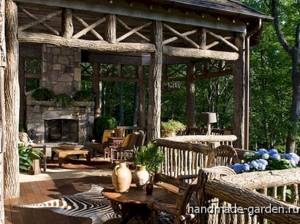
Natural style is simply ideal for a small area, where functional areas must be presented in the most complete set and there is no way to visually isolate them from each other. However, it is no less good for large areas, because historically many Russian estates were developed precisely according to this principle: a garden with linden alleys, centuries-old oaks, impenetrable thickets of rose hips and jasmine served as a natural continuation of the surrounding landscape.
A natural garden makes it possible to significantly save money on landscaping. At the same time, the artistic concept does not suffer in any way. The natural style allows for a flexible approach to solving any problems that arise during construction.
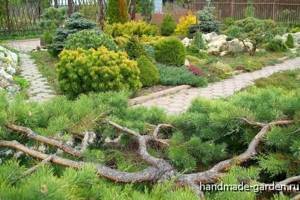
Landscape parks and oriental gardens - “... the gracious simplicity of nature”
The idea of creating artificial park compositions reminiscent of natural landscapes is far from new. Another ancient architect and architectural theorist, Vitruvius, author of the famous “Ten Books on Architecture,” in his works speaks of the harmonious combination of cities being built with the natural landscape. And in 1713, the British poet Alexander Pope published an article criticizing the deliberate decorativeness of the garden, admiring “... the amiable simplicity of nature.”

Nature is the most outstanding landscape designer, and gardening art is a way of creating a man-made natural corner.
English landscape gardens
Regular French gardens of the Baroque era are a symbol of man's complete control over nature. Landscape park ensembles, on the contrary, demonstrate the unity of man with it. This concept can be seen in English landscape parks as a counterweight to the regular French style, which appeared largely thanks to the work of landscape architect Andre Le Nôtre, court gardener to the French king Louis XIV. The founders of the landscape tradition in gardening art were the British: architect William Kent and gardener Charles Bridgman. And the most prominent representative who created gardens in this style is Lancelot Brown. Since the 18th century, this tradition has gradually spread to many countries. Until the 19th century, such gardens were called Anglo-German, but today they are called English.
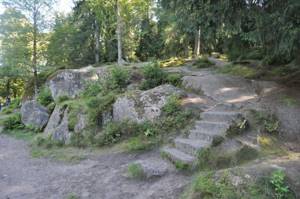
In my opinion, an excellent example of a natural park is Mon Repos Park in Vyborg, created in the 18th century. Most of it is a natural northern forest landscape with numerous rocks. Landscape gardens include the gardens and parks of most Russian noble estates. And this style is still widely used in the creation of public city parks.
The Eastern Garden is the embodiment of idealized nature
The concept of a natural garden is also the basis of oriental - Japanese and Chinese - gardens. Garden art in the East is the creation of an ideal natural landscape, embodying the variability, naturalness and grandeur of nature.
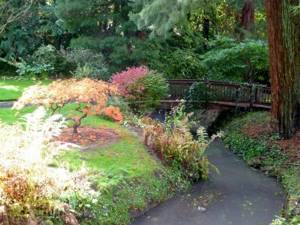
According to the religious beliefs of Shintoism, deities did not have a specific incarnation. They were identified with stones, water, plants and natural phenomena. Therefore, contemplation of a garden for a Chinese or Japanese is a bliss experienced from communion with God, and the garden itself is a temple of worship before the greatness of nature.
Alpine gardens
Another popular option for natural gardens is alpine irokariya gardens (rock gardens). In our country they are better known as alpine slides. This type of garden imitates natural mountain landscapes. The fashion for creating stone gardens using representatives of the flora characteristic of mountainous areas began in 1767. John Blackburn created the first private garden from natural stone boulders in order to plant plants found on the mountain slopes. At that time, “herbarization”—collecting plants—became a fashionable activity among wealthy members of the middle class. Lovers of exotic specimens of mountain flora were faced with the fact that the “Alpines,” torn out from their usual habitat, did not want to take root on the plain.
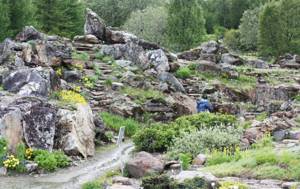
The emerging interest in mountain plants stimulated the development of an entire branch of horticulture - alpine gardens. Reginald Farrer, a researcher and classifier of the flora of the Himalayas, was the first to formulate aesthetic criteria for creating an artificial rocky landscape. By the way, mountain plants were luckier than others: they fell into a fashionable trend. However, a natural garden can be made up of more than just slope dwellers.
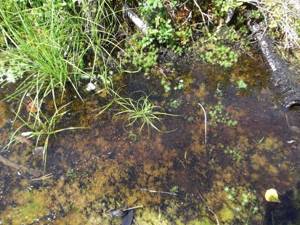
You can create artificial arctic gardens, decorative areas of swamps - any natural landscape is amazing and beautiful.
Origins of landscape design
There is not much time for the concept of landscape design that is familiar today. As a separate type of activity associated with the formation of the human environment, landscape architecture and its component - landscape design - have a history of no more than a hundred years. Meanwhile, the art of creating gardens and parks is much more ancient.

Design made the beauty of gardens more accessible to the masses, not just the upper classes. Not only palace gardens and parks began to be decorated, but also areas of small cottages, and in cities public gardens and parks were established. Interest in landscape design is associated with general trends in the development of society at the turn of the 19th and 20th centuries. The Pre-Raphaelites, the Impressionists, the Arts and Crafts Movement - all this influenced the formation of modern design in general and landscape design in particular.
“To come up with the perfect garden to compliment the house...”
One of the first, or rather, one of the first, who stood at the origins of the profession of landscape design, can be called Gertrude Jekyll, an English artist who learned the art of painting from the Impressionists in France. A quote from her book appears in the title of this section. By the age of forty, she began to lose her sight and was forced to give up painting. She found a new hobby for herself, which later became her life’s work and brought fame - creating gardens. It was the ideas of impressionism that became the basis for more than 300 gardens, designed by her independently and in collaboration with the architect Edwin Lutyens. They said about their creative tandem: “The house is from Lutyens and the garden is from Jekyll.” The result of their joint work was the birth of a unique, recognizable English style in the architecture of private houses and the design of gardens, which has become a role model for many to this day.
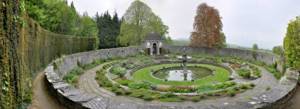
For the first time, the garden became a logical addition and continuation of the architecture, and not a separate phenomenon. Lutyens created the overall large-scale plan, and Jekyll developed the details and selected plants that could emphasize the architectural design. Gertrude Jekyll's gardens are as colorful as the paintings of her beloved Monet. She is believed to be the inventor of a new method of garden art - “painting” with plants. Jekyll valued them for the decorative, complementary effect they created in group plantings, and not for the rarity of the variety or the beauty of an individual specimen.
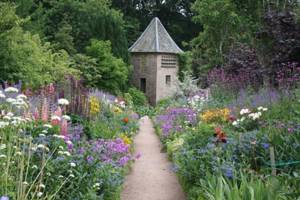
She was the first to think about the issues of combining colors in landscape compositions, about the decorativeness of plantings throughout the season, about creating a garden “... not for boasting, but in union with the environment, in the language of this area”
“Wild” garden: “... you can achieve an impressive effect with simple means!”
William Robinson, an Irishman, was a fan and popularizer of the so-called “wild gardens.” The title is a quote from his book The English Flower Garden. He called for using not exotic capricious plants as planting material, but representatives of local flora that are resistant to weather conditions, diseases and pests. In 1870, Robinson published a book, The Wild Garden, in which he outlined his views. Gertrude Jekyll was also inspired by his ideas.

William Roobinson developed the theory of creating small gardens within a whole garden, in accordance with specific soil conditions: rockeries, aquatic plant gardens, ornamental swamps. In his book, the author examines the types of ornamental wild plants in England. However, he was not an unequivocal opponent of introduced plants (those that are not native to a given territory): Robinson advocated using only those exotic plants that were well acclimatized and capable of surviving the winter on their own.

William Robinson designed several gardens, among which the most outstanding of his creations in the style of a “wild” garden is his own Gravetye estate, which became the subject of controversy and admiration of his contemporaries.
Natural garden design elements
The Naturgarden style is so versatile and flexible that it can be used to decorate almost any part of the garden: from a recreation area with a barbecue fire and deliberately rough garden furniture to a children's playground.
A picnic area created in natural style with a house built in the crown of a tree; from a shady flower bed to an elegant mixborder in the front garden.
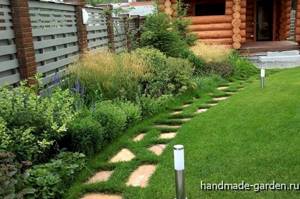
The main thing when landscaping a garden in a “natural” style is to follow its basic principles.
On the site you can identify all the necessary functional areas: recreation, front entrance, orchard and decorative vegetable garden. What is important is a competent layout that would allow them to be rationally placed on the territory, while deliberately leaving islands of untouched nature on the site.
When creating a “natural” garden, you need to strive to preserve the natural topography, soil, and existing plants.
Special attention should be paid to the color scheme of the object. A light beige shade can be an ideal option for a home and outbuildings. The choice of light colors is especially welcome in shaded areas. You can also decorate other details in light colors - a bridge, a bench.

“Naturstil” provides for the creation of as diverse landscapes as possible in the garden - from a “dry stream” to a deep reservoir, from a sunny meadow to a gloomy forest. For example, light spots of buildings, echoing the white trunks of birch trees, will successfully set off the spruce trees. The garden exudes special charm, in which the emphasis is on separately planted coniferous and deciduous trees, contrasting with the light carpet of the lawn and light-colored buildings.
Plants for a natural garden
The garden, in which the main thing is naturalness, is especially beautiful in the spring, so the main attention is paid to flowering shrubs. Among them are Deutzia graceica, Tatarian honeysuckle and spirea.
Living pictures will help you create flowering ornamental plants - lumbago, lilies of the valley, daffodils, tulips, irises and lipsticks. Forget-me-not, agrostemma, cornflower and bindweed will add ease. Foxglove, aconite, xeranthemum and chamomile will create a special mood in the summer. To create light clouds hovering over the lawn, gypsophila, yarrow, cuff and anaphalis are ideal.
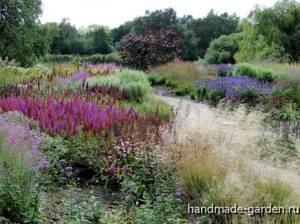
However, in modern natural-style gardens, ornamental grasses are increasingly taking on the leading role, but not as the usual evenly trimmed lawn, but in its most natural form.
The most important thing is a delicate approach to landscaping. When forming a garden, it is necessary to generally preserve the spirit of the surrounding landscape. “Naturgarden” is not just one of the styles of garden design: it is a special art, a way of thinking that makes it possible to live in harmony with oneself and nature.
"New wave" in landscape design
In 2000, at one of the most prestigious exhibitions of floriculture and landscape design in Chelsea, under the motto “Inspiration from Nature,” the Evolution garden was presented. This project took first place in the show, and the composition was thistle. The author of the project was the Dutch designer Piet Oudolf in collaboration with Arnie Maynard.
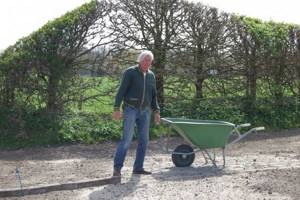
This victory in the competition is considered the beginning of a new era in landscape design. You can often come across the opinion that the “new wave” is a design style in garden design, and its author is Piet Oudolf. This is not true: New Wave is a concept. This term denotes a direction in art that is radically different from its predecessor. The design of a new wave garden can be anything, the main thing is that it fits within the framework of the idea. What are they, frames? The main difference between the New Wave garden and its predecessors is that the form and structure in it are primary, and the color is secondary.
Garden art by Piet Oudolf
Piet Oudolf developed his own classification of plants used to create his flower beds. It takes into account the habit (shape, appearance) of the plant, the shape of the inflorescences, and height. The designer gave his names to the various forms of inflorescences:
- "daisies"

This group includes plants with chamomile-shaped inflorescences - perennial asters, chrysanthemums, heleniums, rudbeckia, echinacea, cornflower, calimeris.
- "balls and buttons"
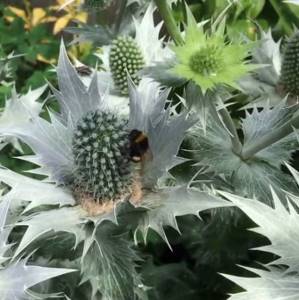
These include mordovnik, burnet, onion, eryngium (eryngium), starwort (astrantia) - plants with spherical inflorescences.
- "umbrellas"

Piet Oudolf in his flower beds uses plants that have the shape of inflorescences in the form of umbrellas: the usual phlox, recently popular yarrows, angelica (angelica), tansy, sedum, spurge.
- "candles"
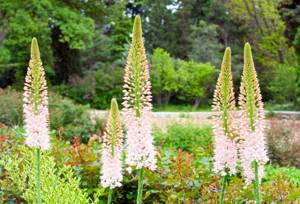
These are plants that have vertical inflorescences in the form of a spike or cob: aconite, lupine, woolly auricle (sheep's ear), veronicastrum, delphinium, foxglove, sage, mullein, buzulnik, eremurus (shiryash) and many others.
- "brushes"
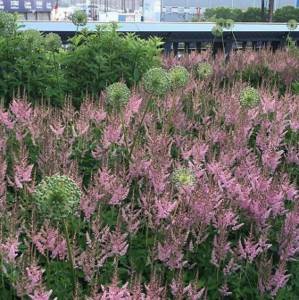
The group includes ornamental plants with inflorescences in the form of panicles: astilbe, aruncus dioecious (volzhanka), goldenrod, meadowsweet, and cornflower.
- "veils"

This category includes mainly cereals - pike grass (turfgrass), reed grass, millet, feather grass, oats. The main thing is that they create a translucent haze with their inflorescences. Flower beds of the “new wave” are based on the natural principle. Have you paid attention to what the forbs of meadows look like? The basis of the natural composition is perennial grasses, arranged in picturesque clumps, intersecting and flowing into each other. This whole picture is complemented by interspersed annual plants scattered across the entire surface. This principle is taken as a basis by the designer.
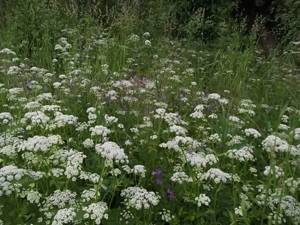
The composition of the Udolfian flower garden is based on the harmony and contrast of the shapes of “daisies”, “tassels”, “umbrellas”, “candles” and “buttons”, and curtain plants create the necessary density and flair of the flower garden. Representatives with daisy-shaped inflorescences make up the bulk, and they mainly carry the coloristic load in the composition. Tall “candles” define the verticals, “umbrellas” – the horizontals, “brushes” connect the arrays of plants with sealing strokes. “Balls” and “buttons” serve as structural accents, rising above the plant mass and swaying in the wind. Smoky curtain plants add completeness, draping the entire composition with a light trail.
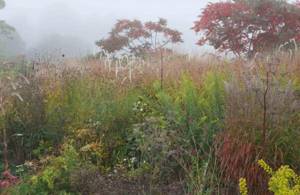
Another feature of the flower beds created by Piet Oudolf is that they are decorative throughout the year. In our gardens, a common sight is plants wrapped for the winter in improvised, not always attractive, means. In the new wave gardens, all representatives are selected in such a way that their decorative effect is maintained all year round. In spring, early blooming flowers delight the eye: snowdrops, crocuses, scillas, species of tulips and daffodils. Throughout the summer, various meadow flowers replace each other, and in the fall the garden is decorated with dry ears of cereals. In winter, dried plants are beautifully covered with frost.
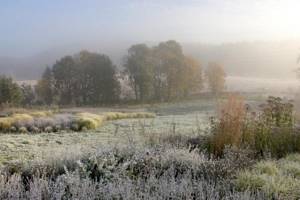
The Dutch designer was one of the first to revolutionize cutting off faded inflorescences, believing that “...why remove faded flowers or beautiful inflorescences? Why remove faded rose flowers if beautiful rose hips appear later?”
Differences between gardens in the Naturgarden style
What are the differences between a natural-style garden and a natural and eco-garden? In my opinion, the division can be roughly done like this:
- The eco-garden assumes the absence of artificial irrigation, molding, and the use of synthetic fertilizers and chemicals in the fight against pests and diseases. What plants are planted in it and in what order remains at the discretion of the owner.
- A garden in a natural style involves a skillful imitation of the natural landscape by the designer in order to “... create a feeling of nature, spontaneity” (Piet Oudolf), to form one’s own vision and sense of the beauty of nature, transformed through the prism of good design. In a natural style garden there is a place for itopiary, modern art objects, and clear geometry of plantings.
- A natural garden is a biotope created by nature, which is slightly improved by man. For example, as in this photo: an unmowed natural meadow combined with mowed paths.
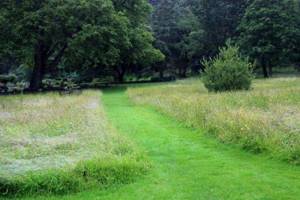
In any case, before you fight over names, you should decide for yourself what kind of garden you want to create.
Natural style garden
It is no secret that in almost all countries with deep traditions of ornamental gardening and magnificent parks that capture our imagination, interest in natural “wild” landscapes has increased in recent years. At the most prestigious exhibitions, displays that reproduce the ecosystem of a swamp, meadow, virgin forest, etc. win. City dwellers, who are hungry for simple, but so understandable and sincere colors, are especially persistent in striving for this style. The most modern parks in Chicago, Singapore and Hong Kong transport city dwellers, always in a hurry on business, to prairies and savannahs, jungles and mountains. Even in the landscaping of high-tech buildings, compositions of cereals and wild herbs look most advantageous in contrast with hard lines and shapes. In our country, this style of design is most in demand in areas allocated in the forest zone, which is not uncommon lately. Or maybe you just dream of enjoying a vacation on your property, as if you were far beyond the borders of civilization. Then our advice will help you with this.
Of course, when we talk about a “wild” garden, we do not mean a neglected and unkempt one, where plants grow on their own and have turned into impenetrable “hashes.” Few people find vegetation attractive in a neighboring planting or along the road and would like to have it in their garden. We all understand the difference between stylization, for example, “antique” and real rarities, antiques; there are even special techniques for “aging” things, etc. So it is here: the “wildness” of the garden must be carefully planned, it is necessary to think through the outlines, lines and materials that will create a special atmosphere.
I personally like the approach of the masters who notice the most beautiful and harmonious pictures in the natural landscape, thoughtfully analyze why it is beautiful, pleasing to the eye, what it consists of, what laws it is built by, and then try to put such a picture together like a mosaic in their gardens.
For those who want to create their own “wild garden”, two main tasks need to be solved step by step. On the one hand, it is necessary to first build various objects for living, recreation and work, connect them with paths and platforms, and then proceed directly to the selection of an assortment of plants characteristic of the selected natural community. Naturally, for complete harmony it is necessary that all buildings and even fences be made in a suitable style, for example, a wooden log house or chalet, or be finished with natural materials (wood, natural stone or imitations of them).
If this is not possible, then the distant areas of the garden are decorated in a natural style, visually separating them with curtains of trees and shrubs.
It is also important at the planning stage to give the paving and contours of flower beds a rounded, “streamlined” shape. Look at the paths that people and animals trample in the forest. Not a single right angle, no sharp or small bends, no flashy contrasts that beginner gardeners are guilty of. Only smoothly flowing lines that bend around obstacles. For finishing paving, you also need to choose natural materials: stone, wood, pebbles, for mulching - decorative crushed stone or crushed bark. However, here too you should avoid geometric shapes, clear patterns and contrasting color combinations, which are sometimes used in modern design. In areas located in the forest, where there is especially little light between closed trees, you can mulch the surface with fallen pine needles and pine cones. This mulch looks very natural and original, and it’s practically free. Fits very nicely into the landscape (natural) style of an area of imitation water or a “dry river bed”, recreated with the help of pebbles or small gravel, possibly with a bridge, water devices in the form of a spring, a “crying stone”, paths made of separate slabs, between which a gradually growing moss or self-seeding ground covers. Next to the path, dig in “grown into the ground” boulders, weathered and covered with lichens.
It has also become traditional to paving paths and platforms in forest areas from transverse wooden cuts or timber beams with a rectangular cross-section 20-25 cm wide and 15-20 cm thick, laid along or across the path. Long-lasting paths and steps are made from old sleepers. The most suitable wood for harvesting is aspen, oak or black alder. But pine, of course, is more accessible and more often used. In order to make a path, you need cuts 10-15 cm thick and at least 20 cm in diameter. The most interesting is the combination of “round pieces” of different diameters. If you show ingenuity and imagination, combine several materials that are harmonious in color and texture, such a path will not only be economical, but will also become a feature of your site.
Sometimes, for paths in a landscape-style garden, backfilling is used on top of the lower underlying crushed stone layer with gravel or screening out granite rocks with a grain fraction of 3 to 10 mm. However, we must remember that bulk materials are difficult to clean from leaves, mown grass, and in winter from snow. Gravel spreads on your feet, and therefore, every few years, the paths will have to be renewed, adding fresh ones. To prevent gravel from spreading, paths can be limited with boards, stones or other suitable materials.
For the construction of gazebos, garden furniture, swing supports, pergolas, etc. You can use logs, stumps, thick branches of attractive shape, removing the bark and treating them with special impregnants. Often for these purposes, so-called “floaters” are used - trunks that have lain in water for a long time, thrown ashore and dried. They have an interesting shape, however, working with such material requires artistic taste and skill.
Regarding the selection of an assortment of plants for a “wild” garden, I suggest remembering that people themselves, according to their own taste, determine which plants are considered weeds and which are beautiful garden flowers worthy of growing in our gardens. Meanwhile, all plants originally grew somewhere in the wild and can be harmful weeds in their homeland. Aglaonemas, monsteras, begonias, regal orchids, etc. grow quietly along roads in countries of the corresponding climatic zones. Only an attentive person appreciated their natural beauty and brought it into our gardens. Later they were cultivated, new varieties were developed and began to be considered domestic. In the most luxurious English gardens, our malicious weeds and their relatives - thistle, mordovnik, yarrow, eryngium and many others - cause delight. Perhaps we, too, need to learn to see the beauty of familiar plants and bring them into our gardens. As a rule, plants from other countries and continents seem more interesting to us. When starting to plan an assortment of plants, you also need to understand what kind of landscape (or rather biogeocenosis) in this place you want to reproduce (meadow, forest edge, shore of a reservoir or dry gravel scree). Then you will have to start by creating the appropriate conditions, or select plants to match existing ones. In nature, all natural processes are so established that every piece of territory with a certain set of factors will be populated by living organisms adapted specifically to these conditions (temperature, light, moisture, soil-nutrients). By compensating for the missing element, you can significantly expand the range of plants grown. Without changing anything on your site, you can easily grow only those plants that are already growing in your neighborhood, plants of the same zone from another continent (for example, North American), or a more severe climate zone. There is a large assortment of very stable, unpretentious plants, usually species (taken from the wild), but their decorative qualities may not always suit us. Therefore, we have to look for an alternative: either create conditions for attractive and more demanding plants, or plant representatives of natural flora on your site. Usually we look for the “golden mean”, combining both.
You can make it cozy and peaceful, and isolate your wild garden from the surrounding view using curtains of trees and shrubs, especially conifers that grow naturally in our or a similar climate, or their varieties with an interesting habit or unusual shape of leaves, flowers, and branches. To integrate new plants into the natural landscape, choose varieties with discreet, pastel-colored flowers. In a wild garden, you should not get carried away with decorative foliage, especially purple and golden ones; they can only be present and slightly shade the greenery of other plants. Moreover, do not make too contrasting combinations, diluting the plantings with neutral and transitional shades.
Some of the most unpretentious (up to zone 2) are various varieties of the beloved and familiar warty birch (Betula pendula) with different crown shapes, from columnar to weeping - 'Youngii', 'Goldbirk'; birch with purple foliage can be planted as a color accent - 'Purpurea' or with gracefully dissected openwork foliage - 'Laciniata'.
Up to zone 3, you can successfully grow fragrant bird cherry trees: common bird cherry (P. padus) and medium-sized virgin bird cherry (Padus virginiana) with an almost round crown, reaching 4-6 m, covered in clusters of fragrant flowers in May. The trees are quite unpretentious, but grow best in humus, moist soil.
Also pay attention to the very unpretentious (zone 2), original varieties with openwork carved leaves of gray alder (Alnus incana 'Laciniata') and black alder (A. glutinosa 'Laciniata').
I can’t imagine a natural-style garden without the common rowan (Sorbus aucuparia), which is spectacular both in the spring during flowering, when it is covered with large (up to 15 cm) cream-colored inflorescences, and in the fall, covered with clusters of scarlet berries, delighting both people and birds. Of course, we cannot do without beautiful flowering trees, for example, apple trees of the Far Eastern and North American species. The abundantly flowering apple tree (Malus x floribunda), exported back in the 19th century from Japan, is very beautiful when the purple buds on graceful branches gradually open into white and pink flowers, or the Siberian berry apple tree (M. baccata) with white flowers. If you want to have a tree with pink flowers, you should plant a very frost-resistant, unpretentious, pest and disease resistant Nezdwiecki apple tree (M. niedzwetzkyana) - a small tree with leaves that are purple during the blooming period and later turn green on the outside, and the flowers are deep pink. By autumn, the tree is covered with a mass of small, burgundy apples, which gives it additional decorativeness.
A natural style garden cannot be complete without shrubs. In the background of the mixborder, species of lilacs are very good, for example, Hungarian lilac (Syringa josikaea), growing in the form of a large openwork bush, covered with purple fragrant inflorescences, or the more compact Meyer lilac (Syringa meyeri). The prickly rose (R. pimpinellifolia) is covered with white or yellowish flowers in May, and the gray rose (R. glauca) is a large bush with shiny blue-green leaves with a reddish tint (yellow and red-orange in autumn), blooms purple in June-July -red flowers, and in July orange-red spherical fruits ripen.
Mountain ash (Sorbaria sorbifolia) is a large bush with characteristic feathery leaves, especially beautiful during flowering, when it is covered with white paniculate inflorescences.
Similar to it is the Volzhanka dioecious (Aruncus dioicus), native to the western regions of the European part of Russia, the Caucasus and Central Europe, a perennial plant up to 2 m tall with complex, double-pinnate leaves and white paniculate inflorescences
In the foreground, closer to the path, plant cinquefoil (Potentilla): low (P. supina) - a beautiful shrub with a creeping, uneven habit (reaches 60-80 cm in height) slightly blue-green leaves, has varieties with white, yellow and red flowers (zone 3), or shrubby (P. fruticosa)
Interesting shrubs for a wild garden are numerous types of honeysuckle. Tatarian honeysuckle (Lonicera tatarica) is our endemic, blooms with pink fragrant flowers, is very stable and unpretentious.
Red honeysuckle (L. xylosteum) is a shade-tolerant shrub, 3-5 m in height, first producing yellow-white flowers, and then dark red inedible, but quite decorative berries. Tolerates dry sandy soil. Maack honeysuckle (L. maackii) has an umbrella-shaped crown and red berries that hang on the bush for a very long time.
If you are planning a shady garden, there is room for mahonia holly and snowberries. White snowberry (Symphoricarpos albus) is a low branched shrub up to 1.5-2 m -3 high, especially beautiful in the fall, when it is completely covered with spherical, white fruits so that from a distance it looks like a blooming spirea.
Flowering and decorative deciduous perennials and ground cover will take their place under the canopy of trees and shrubs. Naturally, it’s impossible to list everything, but I can’t imagine a natural garden without some.
The drooping flowers of aquilegia (columbine) look very cute. Blue aquilegia (Aquilegia caеrulea) is a spreading bush 40-50 cm with large, bluish-green leaves and soft bluish-lilac drooping flowers (winter-hardy to -40 degrees). Fan Aquilegia (A.flabellata) has varieties with pure white, blue-white or solid blue flowers. Common aquilegia (A. vulgaris) has very decorative varieties with white, pink or purple flowers (hardy to -35 degrees).
Everyone's favorites are also the peach-leaved bells (Campanula percisifolia) and the crowded bells (C. glomerata), which bloom in early summer with characteristically shaped blue-violet flowers (zones 3-8). Very similar is Platycodon grandiflorus, which also has tall and compact, blue, pink and white varieties. In a natural garden there must be a place for everyone’s favorite daisies. This could be chamomile (Matricária recutita) or yellow chamomile (Anthemis tinctoria), or different varieties of garden flower (Leucanthemum maximum, Chrys.leucanthemum).
If you have enough space in the sun for your wild garden, surprise your guests with luxurious eryngium bushes (our endemic is flat-leaved eryngium (E. planum), but other species are much more beautiful - alpine (E. alpinum), amethyst (E. amethystinum) and etc.) or ball-headed chinstrap (Echinops sphaerocephalus).
They will complete the picture and create a wonderful carpet under the canopy of tall plants that are often found in our gardens and parks, on the edges of deciduous forests, ivy leaf (Clechoma hederacea), lily of the valley (Convalaria majalis), small periwinkle (Vínca mínor), European hoofweed (Ásarum europaéum), Corydalis (Corydalis cava). Also suitable for this are Duchesnea indica, Ajuga reptans, Lamium galeobdolon and Tiarella cordifolia.
Instead of a traditional lawn in a natural garden, you can arrange a so-called Moorish lawn, which is a motley mixture of various plants - cereals, annual and perennial flowers, and even bulbous ones, reminiscent of a natural flowering meadow. Often, instead of cereal grasses, the basis of the “Moorish lawn” can be plants of the legume family, for example, creeping clover, white clover (Trifolium repens) and horned grass (Lotus corniculatus), which blooms with yellow flowers. Lyadvenets is able to grow on poor, dry soils, but at the same time tolerates short-term waterlogging. Creeping clover develops normally on soils of varying moisture and fertility in a wide pH range. Both plants are light-loving. A wide range of annual and perennial plants can be included in the grass mixture.
If your site is very sunny, you cannot do without drought-resistant perennial and aromatic plants, such as: speedwell (Veronica spicata), deltoid carnation (Dianthus deltoides), hybrid yarrow (Achillea hybride), oak sage (Salvia nemorosa), veined catnip ( Nepeta nervosa), Fassen's catnip (Nepeta x faassenii) and many others. Cereals, even varietal ones, fit perfectly into the “wild garden” in any combination and quantity.
Plants of the “wild garden” are very unpretentious and require virtually no intervention from you if the right place is chosen for them. However, such a garden still needs care; you will have to remove excess self-seeding, control that some plants do not suppress or crowd out others, and trim dry leaves and faded stems. Of course, your creation will become a real “natural” garden only after a few years, when the plants acquire their normal size, self-seeding or moss appears among the stones, and the boundaries of the groups are erased. You should be patient. One thing is certain: creating a “wild garden” will give you great pleasure even at the stage of planning and direct work, and even more so then you will be able to fully enjoy your holiday in your man-made corner of nature
All photos were taken by the author on the sites he designed.
Victoria Roy landscape designer specifically for the gardening online portal


